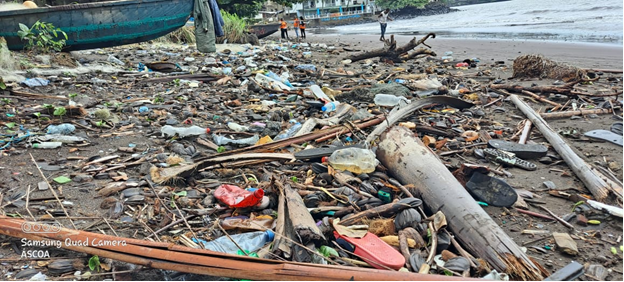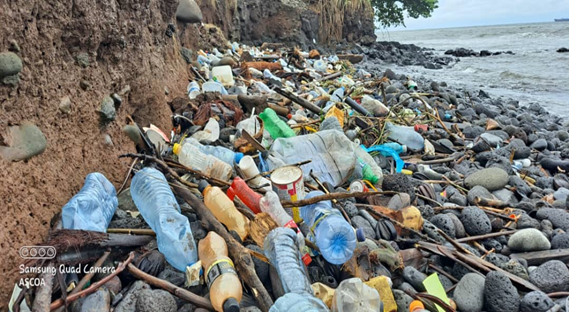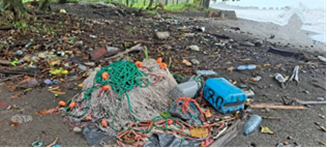INTERNATIONAL COASTAL CLEANUP DAY 2022
International Coastal Cleanup Day got its start in 1986 when Linda Maraniss met Kathy O’Hara while working for Ocean Conservancy. Maraniss had just moved to Texas from Washington, D.C. and O’Hara had just completed a report called Plastics in the Ocean: More Than a Litter Problem. Concerned about the negative effect of plastic in our waters, the two of them reached out to other ocean-lovers and organized a Cleanup for Ocean Conservancy. The first cleanup consisted of 2,800 volunteers. Since then, the cleanup has grown into an international event in more than 100 countries.
ASCOA’S AGREEMENT
Every year ASCOA joins Ocean Conservancy and the international community to commemorate International Coastal Cleanup Day. This year, ASCOA’s theme is; “CONNECTING PEOPLE FOR A TRASH FREE COASTLINE”. The project for this year is a multiple cleanup site event which will be carried out in five selected beaches along the Limbe Coastline, South West of Cameroon on the 17th of September 2022. These beaches have different characteristics but the most common types of garbage found on them include cigarette butts, food wrappers, plastic straws, plastic bottle caps, fishing vessels and plastic beverage bottles. Plastics are especially harmful as they are non-biodegradable and breakdown into tiny pieces due to the weather and ultraviolet rays. Micro plastics then filter into the environment polluting entire ecosystems. Plastic debris kills over one million marine animals each year. It destroys habitats leading to the extinction of entire species. The impact is felt not only by the aquatic ecosystems but also by the human population that depends on the sea and rivers for food and commerce.
Coastal cleanups require committed volunteers, supporters and partners. ASCOA welcomes partnerships with organizations that align with its environmental protection values.
ASCOA’S Objective for ICC 2022
The International Coastal Cleanup Day will be observed under the theme: CONNECTING PEOPLE FOR A TRASH FREE COASTLINE. It will gather approximately 500 volunteers to take part in the event. These volunteers will be distributed amongst the various beaches. We aim to clean about 500 tons of unsought waste in total. The ASCOA team also aims to document all trash collected from the cleanup exercise. Besides these, the ASCOA team also intends to actively involve the local population by educating the public about the importance of keeping the coast clean, and how to encourage others to keep the waterways free of trash. Although the event focuses on the beaches, conservation of our waters goes beyond the oceans and even those who don’t live near the sea can clean up the lakes and rivers in their community and also learn about the importance of keeping all bodies of water free from debris. Even if you don’t live near the coast, you can still participate in International Coastal Cleanup Day because about 80% of all marine debris comes from a land-based source. In fact, cleaning up your neighborhood is one of the best ways to prevent trash from entering waterways that will carry it to the ocean. You can also join ASCOA by sharing this information on social media to create awareness. Beach cleanups increase public awareness about the accumulation and negative effects of litter in oceans, on coastlines and beaches.
ASCOA’S ACHIEVEMENT ON BEACH CLEANUP
At ASCOA, we are committed to protecting our oceans. Our environmental protection projects have raised awareness about plastic pollution in Cameroon’s South West region. ASCOA’s coastal cleanup projects have helped keep local beaches litter-free.
From 2018 till date, the organization has involved:
1,470
Volunteers in coastal cleanups
1,451,927
Items Collected
927
Tons collected
Brief Background on Marine Debris
The UN Sustainable Development Goal 14 and Aichi Target 11 under the Strategic Plan for Biodiversity 2011–2020 of the UN Convention on Biological Diversity explicitly recognize the need for networks of effective Marine Debris removal. Given the increasing anthropogenic changes facing the marine environment (including climate change, ocean warming, ocean acidification, ocean de-oxygenation, coastal pollution, population increases, and technological changes), there is a critical need to ensure all oceans and coastline is adaptively managed with continuous improvement across all elements of management.
An estimated 18 billion pounds of plastic waste flows into the world’s oceans every year, and this figure is expected to triple in the next 20 years if effective strategies are not implemented. This garbage is a result of poor waste management from towns and cities around the coastline, and also direct littering from tourists and visitors. Waste dumped in run-off channels and rivers is swept into the ocean, polluting the waters and endangering marine life. Non-biodegradable waste such as plastics and other heavier debris wash off at the coastline, settle at the sea bed, and destroy marine habitats.
HOW CAN WE FIGHT MARINE DEBRIS?
ASCOA believes that a four key integrated strategy plan is the best way to address the problem of Marine Debris. These four strategies, despite having particular agendas, will be articulated together to achieve the objectives. Taking into account the expertise and previous experience of ASCOA, we bring an intricate approach towards the collection and better administration of marine litter, focusing primarily on its prevention, reduction and collection, processing (recycle and reuse) and commercialization. Through the mobilization of the local population affected by marine pollution, the local champions and advocates will design and implement awareness strategies tailor-made for the local culture and with the support of duty bearers, community gatekeepers, and local authorities we will raise the profile of the issue. In urban areas and selected zones off the coast, ASCOA will target residents of all ages, who are often the main contributors to the trash problem, for awareness raising and education about waste reduction. Secondly, we will focus on the recycling, reuse, and commercialization of marine waste, establishing a system to collect and commercialize waste through recycling, this will be done by partnering with recycling companies/individuals. The advocacy work will be done through the wide range of partners ASCOA already has, and then expand to a network of civil society organizations and other like-minded organizations and businesses committed to environmental protection and sustainability. The approach is the best because it involves all actors, and it aims at both mitigating and adapting to the problem. The project works with public and private sector actors as well as representatives of the civil society.
About Limbe Coastline
The Limbe -Idenau Coastline area in Cameroon:
It covers 43 km of coastline, which includes black sand beaches and mangrove forests. These serve as nesting grounds for bird species like the critically endangered sociable lapwing, as well as four species of marine turtles, the African manatee, and other species listed as ‘vulnerable’ by the International Union for Conservation of Nature (IUCN). The ecosystem in this and its surrounding forested areas are threatened by large quantities of plastic which travel downstream from major urban centres such as Limbe and Douala. This in turn, represents a major public health issue, through contamination of drinking water, foodborne diseases, and other conditions related to pollution.
Indiscriminate dumping of waste on coastal areas and in the sea in Limbe also devalues the area, which depends greatly on tourism to sustain its economy. Efforts must be taken to preserve the natural ecosystem from the threat of industrialization and plastic pollution.
ste Cleaning Network (GWCN), UK.
LOCATION
Below is a brief description of the targeted beaches:

Bobende Beach
Bobende beach extends for over 2km. The Coastline is made up of compact black sand and consists of high human pollution. The entire coastline is covered with littered plastics, fishing vessels, items of local concern, and there is a high concern for foot wears and fishing gears. About 100 volunteers, a team of safety workers, a standby health team, two health personnel and an emergency van will be made available on this site. An estimated 100 tons of weighed waste is expected to be cleaned from this site and cleanup duration will be about 3 hours.

Limbola Beach
It extends for over 2km. The coastline is composed of compact black sand. The shore is stony and littered plastics both from national and foreign companies cover the entire coastline, also, there is high rate of human pollution. A team of 100 volunteers, a standby health team and emergency van is required on this site. And estimate 100 tons of weighed waste, is expected to be cleaned from this site. Clean up duration is about 3 hours.

Mile 6 Beach
Its Coastline extends for over 2km and is made up of compact black sand. Littered plastics from national and foreign companies, foot wears, fishing gears, coconuts waste and other waste of local concern were the main pollutants. There’s a moderate rate of contracting diseases here. About 85 volunteers, at least two health workers, a team of safety workers, a standby health team and an emergency van is required for this site. An estimated 80 tons of weighed waste is expected to be cleaned from this site. Clean up duration is about 3 hours.

Batoke Beach
The Batoke beach extends for over 2km. Its coastline is made up of compact black sand which is covered entirely with littered plastics. Items of local concern are a major source of waste and fishing gears are visible. There’s a low risk of contracting diseases here. This site will have about 75 volunteers, at least two health workers, an emergency van and a team of safety workers. There is an estimated 70 tons of weighed waste to be cleaned from this site. Clean up duration is about 3 hours.

Down Beach
Down beach extends for over 5km. The coastline is composed of black compact sand. The entire coastline is littered with plastics both from national and international companies. There’s a high rate of human pollution from house hold waste. Items of local concern and fishing vessels are common. High risk of marine life entanglement. There is a moderate risk of contracting disease. Over 140 volunteers, at least 4 health workers, a team of safety workers, standby health team and an emergency van is needed for this site. There is an estimated 150 tons of unsought waste to be cleaned from this site. Clean up duration is about 3 hours.
ACTIVITY OVERVIEW
The project will consist of:
- Launching of online application forms for volunteers
- On and off-line training of volunteers
- Collection and disposal of trash
- Recording every item of trash collected through the ‘Clean Swell’ App by Ocean Conservancy App or manually (with data collection form)
- Segregating/sorting the trash you collect. Biodegradable waste will be separated from non-biodegradable waste.
- Spreading awareness by sharing cleanup results and impact with friends through Facebook, Instagram, Twitter, or other social media platform
What do we provide for volunteers?
Before cleanup
- Orientation Webinars/ onset
- ASCOA office 7:00 am for registration and T- shirts
- Transportation
- Gloves, face masks
During cleanup
- First-aid kit for minor cuts and scrapes
- Water
- Hand sanitizer
- Trash bags
- Coordinator form for cleanup data collection
- Pens or pencils for coordinators
After cleanup
- Snacks
- Group photo
- Certificate from Ocean Conservancy
Caution/Dressing
Pending Appropriate Attire: Remember it is always cooler at the beach. Cleanup participants should wear closed-toe shoes such as hiking boots or sneakers, or sturdy sandals with an ankle strap. Also, dress in layers. Prepare for wind and for the temperature to be about 23–25-degree cooler than it is inland.